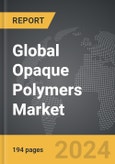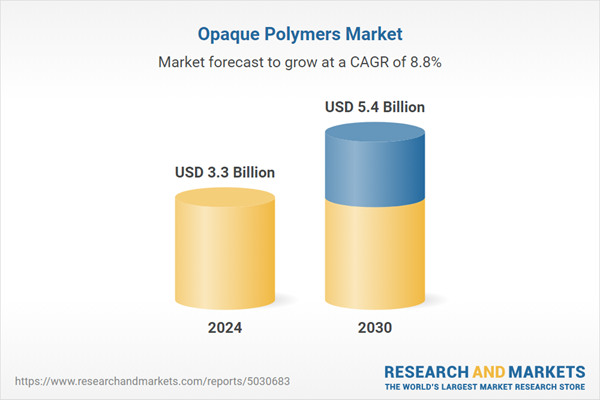The global market for Opaque Polymers was valued at US$3.3 Billion in 2024 and is projected to reach US$5.4 Billion by 2030, growing at a CAGR of 8.8% from 2024 to 2030. This comprehensive report provides an in-depth analysis of market trends, drivers, and forecasts, helping you make informed business decisions. The report includes the most recent global tariff developments and how they impact the Opaque Polymers market.
Segments: Type (Solid Content 30%, Solid Content 40%); Application (Paints & Coatings, Personal Care, Detergents).
Geographic Regions/Countries: World; United States; Canada; Japan; China; Europe (France; Germany; Italy; United Kingdom; Spain; Russia; and Rest of Europe); Asia-Pacific (Australia; India; South Korea; and Rest of Asia-Pacific); Latin America (Argentina; Brazil; Mexico; and Rest of Latin America); Middle East (Iran; Israel; Saudi Arabia; United Arab Emirates; and Rest of Middle East); and Africa.
The analysts continuously track trade developments worldwide, drawing insights from leading global economists and over 200 industry and policy institutions, including think tanks, trade organizations, and national economic advisory bodies. This intelligence is integrated into forecasting models to provide timely, data-driven analysis of emerging risks and opportunities.
Global Opaque Polymers Market - Key Trends & Drivers Summarized
How Have Opaque Polymers Transformed the Paints and Coatings Industry?
Opaque polymers have become an essential ingredient in the paints and coatings industry, offering an effective way to enhance opacity and reduce the use of expensive titanium dioxide (TiO2). Traditionally, TiO2 has been the primary ingredient used to achieve opacity in paints, but its high cost and limited supply have pushed manufacturers to seek alternatives. Opaque polymers, also known as voided latex particles, work by scattering light, thus providing opacity and improving coverage in paints and coatings. This innovation has allowed paint manufacturers to reduce costs while maintaining or even improving the quality of their products. Opaque polymers are also used in other applications such as personal care products, adhesives, and inks, where opacity is a desirable characteristic. Their versatility, cost-effectiveness, and performance have contributed to their rising popularity across various industries.What Trends Are Emerging in the Opaque Polymers Market?
Several key trends are emerging in the opaque polymers market, driven by environmental concerns and advancements in material science. One of the most prominent trends is the push for eco-friendly and low-VOC (volatile organic compounds) coatings, which has spurred demand for water-based paints and coatings that incorporate opaque polymers. As sustainability becomes a greater priority for consumers and businesses alike, manufacturers are focusing on reducing the environmental impact of their products. This has led to innovations in polymer technology that offer similar opacity and performance to traditional materials but with a lower environmental footprint. Another trend is the increasing use of opaque polymers in personal care products, such as lotions and sunscreens, where they improve texture and coverage. In the adhesives and packaging industries, opaque polymers are being used to enhance the appearance and durability of products. As technology improves, the applications of opaque polymers are expanding into new industries, increasing their market potential.How Is Technology Advancing the Use of Opaque Polymers?
Technological advancements have played a critical role in improving the performance and applications of opaque polymers. Advances in polymer chemistry have allowed manufacturers to develop more efficient and cost-effective opaque polymers that deliver superior opacity with less material usage. This has been particularly beneficial in the paints and coatings industry, where reducing the reliance on TiO2 has become a priority. Nano-engineering techniques are being explored to create opaque polymers with enhanced light-scattering properties, further improving their ability to provide opacity while maintaining a smooth finish. Additionally, innovations in water-based polymer systems have led to the development of opaque polymers that are compatible with low-VOC and eco-friendly formulations, addressing the growing demand for sustainable products. 3D printing technologies are also leveraging opaque polymers in additive manufacturing, where opacity and durability are required for specialized applications.What Is Driving the Growth in the Opaque Polymers Market?
The growth in the opaque polymers market is driven by several factors, most notably the rising cost of titanium dioxide and the growing demand for cost-effective alternatives in the paints and coatings industry. Opaque polymers provide a more affordable solution for achieving opacity without compromising on quality, which has made them increasingly popular among manufacturers. Environmental regulations and the shift towards low-VOC and sustainable coatings have also fueled demand for water-based paints, where opaque polymers play a key role. The expanding application of opaque polymers in industries beyond paints, such as personal care, adhesives, and packaging, is another growth driver. Technological advancements in polymer chemistry and nanotechnology have improved the efficiency and performance of opaque polymers, making them more competitive in the market. Finally, the global trend towards sustainable and environmentally friendly products has led to increased investment in the development of eco-friendly opaque polymers, further boosting market growth.Report Scope
The report analyzes the Opaque Polymers market, presented in terms of units. The analysis covers the key segments and geographic regions outlined below.Segments: Type (Solid Content 30%, Solid Content 40%); Application (Paints & Coatings, Personal Care, Detergents).
Geographic Regions/Countries: World; United States; Canada; Japan; China; Europe (France; Germany; Italy; United Kingdom; Spain; Russia; and Rest of Europe); Asia-Pacific (Australia; India; South Korea; and Rest of Asia-Pacific); Latin America (Argentina; Brazil; Mexico; and Rest of Latin America); Middle East (Iran; Israel; Saudi Arabia; United Arab Emirates; and Rest of Middle East); and Africa.
Key Insights:
- Market Growth: Understand the significant growth trajectory of the Solid Content 30% segment, which is expected to reach US$3.8 Billion by 2030 with a CAGR of a 9.2%. The Solid Content 40% segment is also set to grow at 7.9% CAGR over the analysis period.
- Regional Analysis: Gain insights into the U.S. market, valued at $862.3 Million in 2024, and China, forecasted to grow at an impressive 12.2% CAGR to reach $1.2 Billion by 2030. Discover growth trends in other key regions, including Japan, Canada, Germany, and the Asia-Pacific.
Why You Should Buy This Report:
- Detailed Market Analysis: Access a thorough analysis of the Global Opaque Polymers Market, covering all major geographic regions and market segments.
- Competitive Insights: Get an overview of the competitive landscape, including the market presence of major players across different geographies.
- Future Trends and Drivers: Understand the key trends and drivers shaping the future of the Global Opaque Polymers Market.
- Actionable Insights: Benefit from actionable insights that can help you identify new revenue opportunities and make strategic business decisions.
Key Questions Answered:
- How is the Global Opaque Polymers Market expected to evolve by 2030?
- What are the main drivers and restraints affecting the market?
- Which market segments will grow the most over the forecast period?
- How will market shares for different regions and segments change by 2030?
- Who are the leading players in the market, and what are their prospects?
Report Features:
- Comprehensive Market Data: Independent analysis of annual sales and market forecasts in US$ Million from 2024 to 2030.
- In-Depth Regional Analysis: Detailed insights into key markets, including the U.S., China, Japan, Canada, Europe, Asia-Pacific, Latin America, Middle East, and Africa.
- Company Profiles: Coverage of players such as Arkema Group, Croda International PLC, Indulor Chemie GmbH, Junneng Chemicals, Organik Kimya San. Ve Tic. A.S. and more.
- Complimentary Updates: Receive free report updates for one year to keep you informed of the latest market developments.
Some of the 41 companies featured in this Opaque Polymers market report include:
- Arkema Group
- Croda International PLC
- Indulor Chemie GmbH
- Junneng Chemicals
- Organik Kimya San. Ve Tic. A.S.
- Paras Enterprises
Tariff Impact Analysis: Key Insights for 2025
Global tariff negotiations across 180+ countries are reshaping supply chains, costs, and competitiveness. This report reflects the latest developments as of April 2025 and incorporates forward-looking insights into the market outlook.The analysts continuously track trade developments worldwide, drawing insights from leading global economists and over 200 industry and policy institutions, including think tanks, trade organizations, and national economic advisory bodies. This intelligence is integrated into forecasting models to provide timely, data-driven analysis of emerging risks and opportunities.
What’s Included in This Edition:
- Tariff-adjusted market forecasts by region and segment
- Analysis of cost and supply chain implications by sourcing and trade exposure
- Strategic insights into geographic shifts
Buyers receive a free July 2025 update with:
- Finalized tariff impacts and new trade agreement effects
- Updated projections reflecting global sourcing and cost shifts
- Expanded country-specific coverage across the industry
Table of Contents
I. METHODOLOGYII. EXECUTIVE SUMMARY2. FOCUS ON SELECT PLAYERSIII. MARKET ANALYSISSOUTH KOREAREST OF ASIA-PACIFICARGENTINABRAZILMEXICOREST OF LATIN AMERICAIRANISRAELSAUDI ARABIAUNITED ARAB EMIRATESREST OF MIDDLE EASTIV. COMPETITION
1. MARKET OVERVIEW
3. MARKET TRENDS & DRIVERS
4. GLOBAL MARKET PERSPECTIVE
UNITED STATES
CANADA
JAPAN
CHINA
EUROPE
FRANCE
GERMANY
ITALY
UNITED KINGDOM
SPAIN
RUSSIA
REST OF EUROPE
ASIA-PACIFIC
AUSTRALIA
INDIA
LATIN AMERICA
MIDDLE EAST
AFRICA
Companies Mentioned (Partial List)
A selection of companies mentioned in this report includes, but is not limited to:
- Arkema Group
- Croda International PLC
- Indulor Chemie GmbH
- Junneng Chemicals
- Organik Kimya San. Ve Tic. A.S.
- Paras Enterprises
Table Information
| Report Attribute | Details |
|---|---|
| No. of Pages | 194 |
| Published | April 2025 |
| Forecast Period | 2024 - 2030 |
| Estimated Market Value ( USD | $ 3.3 Billion |
| Forecasted Market Value ( USD | $ 5.4 Billion |
| Compound Annual Growth Rate | 8.8% |
| Regions Covered | Global |









